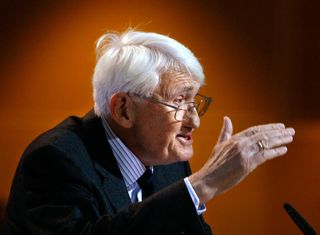
Moritz Koch in Handelsblatt (image: Alex Schmidt, DDP):
Handelsblatt: Professor Habermas, you criticized the German government for behaving like the “Europe’s chief disciplinarian” during the Greece debt crisis. Has Chancellor Merkel redeemed herself with her generosity in the refugee crisis?
Jürgen Habermas: I’m as surprised as I am delighted. For years, I haven’t been thought as highly of our government as I have since late August. Now, here in America, I keep referring to something she said which also keeps being mentioned in the German press.
You mean when she said, “we can manage?”
No, I mean her statement, “If we also have to apologize for showing a friendly face in emergency situations, then this is not my country.” That’s a very strong sentence. Who would have expected that from Ms. Merkel, who has stuck to pragmatic, hesitant statements, oriented towards popular opinion for years? That was a decisive, normative sentence. I was so happy when I read that. And it wasn’t only Ms. Merkel, it was the whole government, and supported by different statements, visits to Heidenau and so on.
You’re all enthusiasm…
What delights me is that once our government finally made a normative statement and took a stand – and then the public reacted in an almost fairy tale way.
You said Berlin was taking a “hegemonic attitude” with Greece, for the first time in the post war era. Now, the right wing is making this same criticism about immigration policy, calling Ms. Merkel’s welcome culture “moral imperialism.”
Well, it’s not surprising that there’s been a reaction to Germany’s decisive policy of opening the borders and our emphasis on the normative content of our already restricted right to asylum. But I can’t take that seriously, the idea that this policy is being associated with a hegemonic attitude from Germany. It’s true that Ms. Merkel’s immigration initiative was a solo effort – followed by a justifiable attempt to create a shared European response.
More here.
While I struggle to keep my legs crossed and take up as little space as possible as a common courtesy to the other passengers on this train, it’s a wonder that you’re so comfortable taking up as much space as you possibly can. I bet you don’t even notice. You must just have some sort of subconscious entitlement to space that persuades you to mark your territory and display your “dominance.” We have been taught to act in opposites. I’ve tried to sit like you once before, and was quickly scolded to close my legs and behave more “lady-like.”


